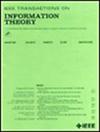The Strong Data Processing Inequality Under the Heat Flow
IF 2.2
3区 计算机科学
Q3 COMPUTER SCIENCE, INFORMATION SYSTEMS
引用次数: 0
Abstract
Let热流下的强数据处理不等式
设$\nu $和$\mu $为$\mathbb {R}^{n}$上的概率分布,$\nu _{s},\mu _{s}$为它们在热流作用下的演化,即它们的密度与各入口方差为s的各向同性高斯随机向量的密度卷积得到的概率分布。本文研究了各种散度(包括$\chi ^{2}$和Kullback-Leibler (KL)散度)的$s\mapsto D(\nu _{s}\|\mu _{s})$衰减率。我们证明了源$\mu $和高斯信道对应的强数据处理不等式(SDPI)系数的上界和下界。我们还证明了de Bruijn恒等式的推广,以及Costa关于$\nu _{s}$的微分熵在s中的凹性的结果。作为我们分析的副产品,我们获得了X和$Y=X+\sqrt {s} Z$之间互信息的新下界,其中Z是$\mathbb {R}^{n}$中独立于X的标准高斯向量,以及根据X的poincar常数从Y估计X的最小均方误差(MMSE)。
本文章由计算机程序翻译,如有差异,请以英文原文为准。
求助全文
约1分钟内获得全文
求助全文
来源期刊

IEEE Transactions on Information Theory
工程技术-工程:电子与电气
CiteScore
5.70
自引率
20.00%
发文量
514
审稿时长
12 months
期刊介绍:
The IEEE Transactions on Information Theory is a journal that publishes theoretical and experimental papers concerned with the transmission, processing, and utilization of information. The boundaries of acceptable subject matter are intentionally not sharply delimited. Rather, it is hoped that as the focus of research activity changes, a flexible policy will permit this Transactions to follow suit. Current appropriate topics are best reflected by recent Tables of Contents; they are summarized in the titles of editorial areas that appear on the inside front cover.
 求助内容:
求助内容: 应助结果提醒方式:
应助结果提醒方式:


